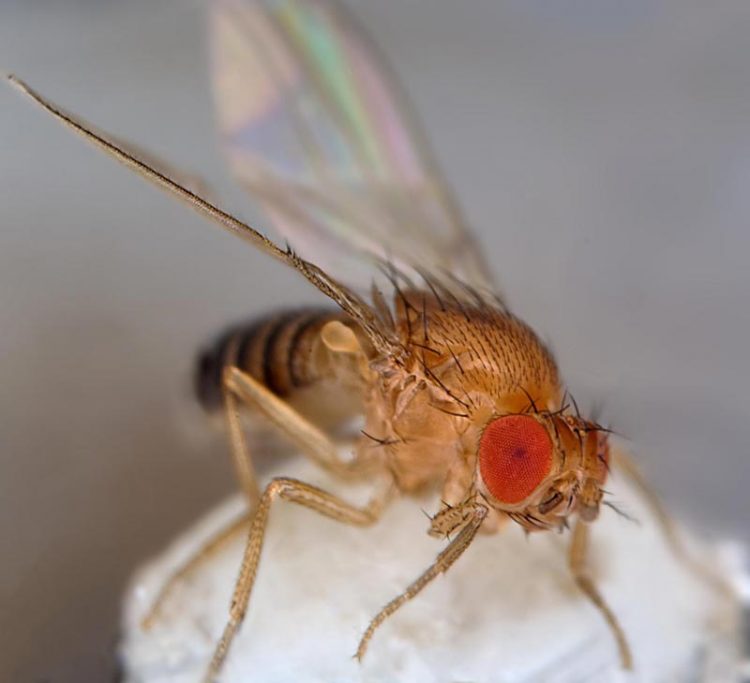Tracing the evolution of vision

Fruit fly: the antennae, that sit between the eyes, function as ears. Credit: Miriam Berger und Dr Bart Geurten
The function of the visual photopigment rhodopsin and its action in the retina to facilitate vision is well understood. However, there remain questions about other biological functions of this family of proteins (opsins) and this has ramifications for our understanding of several evolutionary pathways.
Now, an international research team led by the University of Göttingen has shown there are other functions of opsin outside vision and this provides insights into how the eye evolved. Their research was published in Current Biology.
Vision relies on rhodopsins, which are made from proteins (opsins) that bind with “retinal” (a small molecule derived from vitamin A). This molecule changes its structure when stimulated by light and enables us to see: without retinal, photoreceptor cells die and there is no vision. Intriguingly, in the fruit fly Drosophila, the same opsin proteins that enable vision also occur in the ear.
Researchers from the Department of Cellular Neurobiology and the Institute of Molecular and Cellular Physics of the University of Göttingen therefore asked if these auditory receptors were light-sensitive, i.e. could the ears of this fly also sense light? The researchers quickly discovered that the fly's ear could not function as an eye. What the researchers deduced, however, is a completely new function of opsins independent from the molecule retinal and from the functioning of the eye.
They tested this by making vitamin A unavailable to Drosophila through various experiments: taking vitamin A out of the fly's diet; disrupting the transport protein that mediates vitamin A uptake into gut cells; and blocking the enzyme that converts vitamin A into retinal. This rendered the insects blind – but they did not become deaf. Together with colleagues in the US, the researchers then manipulated the opsins so that they could no longer bind with retinal. As expected, this made the flies blind, but again their hearing remained intact.
This showed that the fruit fly requires opsins (but not retinal) for hearing, adding a new twist to the function of photopigment proteins. The real surprise came when the scientists looked at those enzymes that, in the eye, recycle light-activated retinal back into its light-sensitive form. All those enzymes turned out to occur in the fly's ear as well as the eye and were essential for hearing, even though hearing works without retinal. Hence, not only opsins, but also all the retinal-enzymes, have other important biological functions that are independent of vision.
“From an evolutionary perspective, this is quite striking,” explains Dr Radoslaw Katana, the first author of the study. “The receptor cells for vision and hearing are derived from common ancestor cells, which seem to have used opsins and retinal-enzymes even before vision and hearing were possible. This is also the case in vertebrates: opsins occur in mechanoreceptor cells and many of the retinal-enzymes have remained essentially unchanged throughout evolution and are also implicated in human hearing”.
“The retinal cycle in the eye is the most thoroughly studied biological signalling cascade,” remarks Professor Martin Göpfert. “It now seems that its molecular components originally had nothing to do with the eye or light, revolutionising our understanding of the early evolution of vision”.
###
Original publication: Radoslaw Katana et al. Chromophore-independent roles of opsin apoproteins in Drosophila mechanoreceptors. Current Biology (2019). DoI: 10.1016/j.cub.2019.07.036
Contact:
Professor Martin Göpfert
University of Göttingen
Cellular Neurobiology
Julia-Lermontowa-Weg 3, 37077 Göttingen
Tel: +49 (0) 551 39-177955
Email: mgoepfe@gwdg.de
https:/
Dr Radoslaw Katana
University of Göttingen
Cellular Neurobiology
Julia-Lermontowa-Weg 3, 37077 Göttingen
Tel: +49 (0) 551 39-177966
Email: Radoslaw.Katana@biologie.uni-goettingen.de
https:/
Media Contact
All latest news from the category: Life Sciences and Chemistry
Articles and reports from the Life Sciences and chemistry area deal with applied and basic research into modern biology, chemistry and human medicine.
Valuable information can be found on a range of life sciences fields including bacteriology, biochemistry, bionics, bioinformatics, biophysics, biotechnology, genetics, geobotany, human biology, marine biology, microbiology, molecular biology, cellular biology, zoology, bioinorganic chemistry, microchemistry and environmental chemistry.
Newest articles

A new puzzle piece for string theory research
Dr. Ksenia Fedosova from the Cluster of Excellence Mathematics Münster, along with an international research team, has proven a conjecture in string theory that physicists had proposed regarding certain equations….

Climate change can cause stress in herring larvae
The occurrence of multiple stressors undermines the acclimatisation strategies of juvenile herring: If larvae are exposed to several stress factors at the same time, their ability to respond to these…

Making high-yielding rice affordable and sustainable
Plant biologists show how two genes work together to trigger embryo formation in rice. Rice is a staple food crop for more than half the world’s population, but most farmers…



